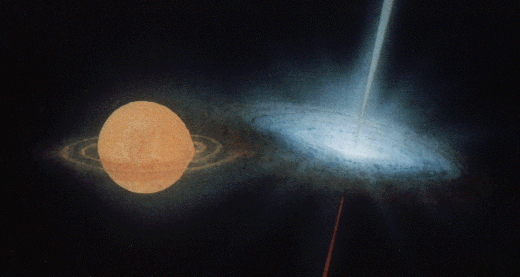
|
Credit & Copyright: NASA
Artist's Visualization
Explanation:
SS433 is one of the most exotic star systems known to astronomers.
Its unremarkable name stems from its inclusion in a catalog of
stars which emit radiation characteristic of
atomic hydrogen.
Its very remarkable behavior stems from a compact
object, a
black hole or
neutron star, which has produced an
accretion disk with jets.
As illustrated in this
artist's vision of
the SS433 system based on
observational data,
a massive, hot star (left) is locked in
a mutual orbit with a compact object. Material transfers from the
massive star into
an accretion disk surrounding the
compact object
blasting out two jets of ionized gas in opposite directions -
at about 1/4 the speed of light! Radiation from the jet tilted toward
the observer is blueshifted, while radiation from the jet tilted away
is redshifted.
The binary system itself completes an orbit in about 13 days while the jets
precess (wobble like a top) with a period of about 164 days.
Are the jets from SS433 related to those from
black holes at the centers of galaxies?
Information:
The
Scale of the Universe Debate in April 1996
|
January February March April May June July August September October November December |
| ||||||||||||||||||||||||||||||||||||||||||||||||
NASA Web Site Statements, Warnings, and Disclaimers
NASA Official: Jay Norris. Specific rights apply.
A service of: LHEA at NASA / GSFC
& Michigan Tech. U.
Based on Astronomy Picture
Of the Day
Publications with keywords: SS433
Publications with words: SS433
See also:
